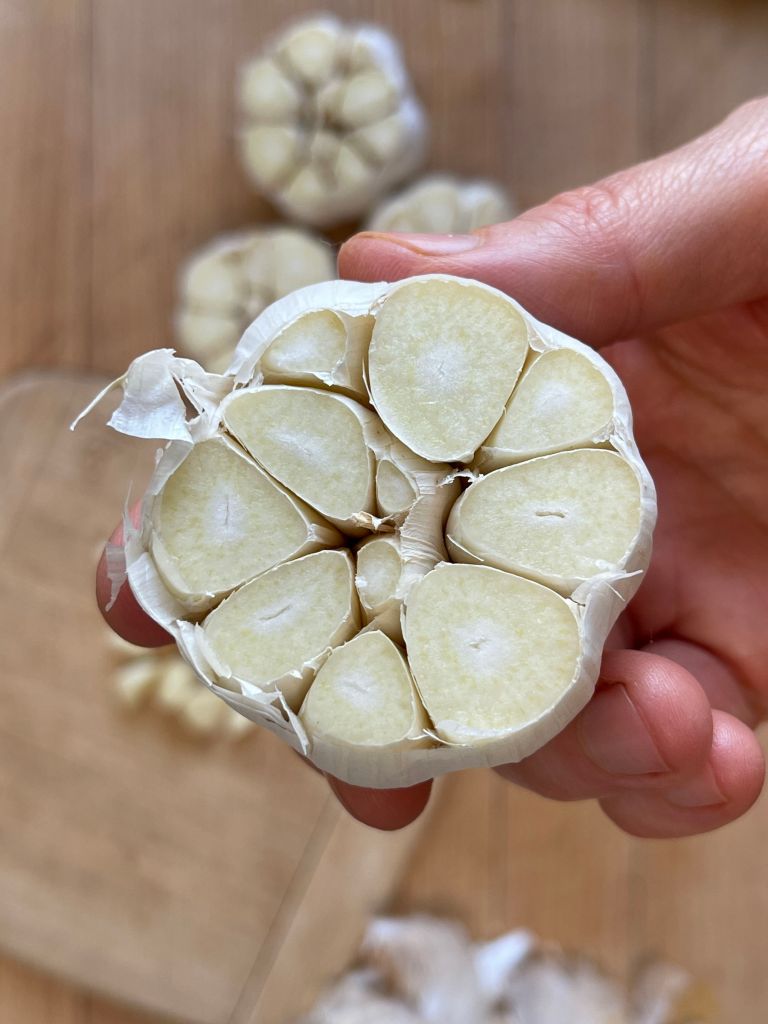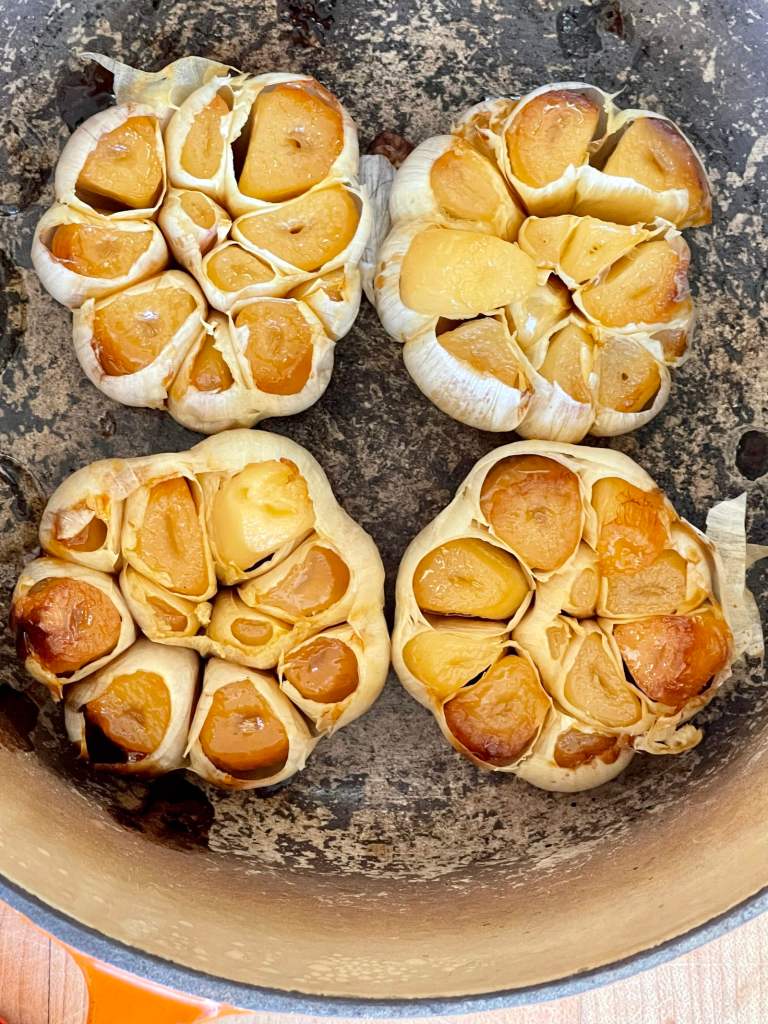You may have learned to make roasted whole heads of garlic by covering the crosswise sliced and prepared exposed heads with tinfoil. Or perhaps you wrap the entire prepped head in tinfoil. When I stopped buying throwaway items but still wanted to eat scrumptious roasted garlic, I had to figure out what to use instead of tinfoil. Well I didn’t have to think long. I had many waste-free options at my, errr, disposal.
I roasted four heads of garlic for this post and wish I had done at least six. Add the caramelized, rich, creamy, mellow garlic to dips such as baba ghanoush or hummus, puréed main dishes such as roasted honeynut squash soup or simply spread it on crackers or toast. Or pop the cloves straight into your mouth (I bet you can’t resist!).
Simple equipment for waste-free roasted garlic
These are just some of the common kitchen items you can use to roast prepped heads of garlic (more on prepping coming up).
- Muffin pan cups. One prepped garlic head fits in one muffin cup (jumbo garlic may be too tight a fit). Cover the entire muffin pan with an overturned baking sheet.
- Baking sheet and small oven-proof dishes. Place the prepped heads on the baking sheet and cover with overturned ramekins or other small oven-proof glass dishes. Or use a glass baking dish as your surface.
- Small Dutch oven. Arrange prepped heads inside and cover the pot with the lid. (Very easy to clean!)
- Small baking dish with a lid. An oven-safe glass casserole dish with a lid also works.
Roasted whole garlic in pictures










Reduce wasted food. Save the scraps!
Use any small ends of the cloves in the top you sliced off the head of garlic. Add these immediately to another dish or store in the refrigerator and use within a day. Go here for more on storing fresh garlic.
Add the roasted garlicky paper to your stash of scraps to later make scrap vegetable broth. The paper will add lots of flavor.
Conserve energy and water with continuous cooking
Save energy by either roasting these in a toaster oven (or toaster oven air fryer) or by roasting a bunch of food at once when you turn on the oven. I decided to roast honeynut squash and a handful of small potatoes along with my garlic. The roasted garlic and roasted honeynut squash will come together later in the week for an amazing soup.
Clean up is pretty minimal. If some of the caramelized garlic sticks to my Dutch oven, as a bit has here, then it’s time to make a small pot of soup or really just about anything savory in that pot (it’s that continuous cooking methond!). More food, less washing!
Just some benefits of roasting garlic
- It tastes amazing. If you find fresh garlic too strong, try roasting it.
- Roasted garlic nearly peels itself. If peeling and mincing fresh garlic isn’t your favorite task, roast a bunch of heads. The delicious garlic cloves easily pop out of the paper and mash easily with a fork.
- Helps prevent food waste. If you have many heads on hand and won’t eat them all before they head south, roast them to prep them all at once. Add then—lots of rich flavor—to your favorite savory dishes. Delicious roasted garlic won’t go uneaten!
If I hadn’t decided to cut waste, I would still be buying tinfoil. This small swap won’t save the world but small actions (and small expenses) do add up and help us change our habits from automatically reaching for disposable items to instead asking “Can I do this differently?” and often discovering that yes, we can.
Roasted Garlic Without Tinfoil
Ingredients
- whole heads of garlic
- ½ to 1 teaspoon olive oil per head of garlic
Instructions
- Preheat the oven to 400°F. Slice off the top of each head of garlic, between ¼ and ½ an inch, to expose the tops of every clove. If a clove is still covered in paper, surgically remove the top with a paring knife.* (see note)
- Place the whole garlic heads on a cookie sheet, in a muffin tin, or a Dutch oven, cut side facing up. Drizzle with olive oil. If any of the cloves are bare, rub on some olive oil with your finger.
- Rub any of the larger top pieces in olive oil that has dripped onto the bottom of the roasting dish. Tuck them into the roasting dish, exposed side facing up. These will roast faster so keep an eye on them to prevent them from burning.
- If using a cookie sheet, cover each head with an overturned ramekin or oven-proof dish. If using a muffin tin, cover with an overturned cookie sheet. If using a Dutch oven or casserole dish, cover with the lid.
- Roast the garlic for from 45 minutes to one hour, until caramelized and soft. Remove from the oven. When cool enough to handle, pop the cloves out of the head with your fingers. They will slide out easily.
- Use the roasted garlic immediately or refrigerate. The garlic will keep in the refrigerator for at least 5 days.
Notes
Check out my award-winning cookbook!
- Taste Canada silver for single-subject cookbooks
- Second-place Gourmand cookbook award in the category of food waste
- Shortlisted for an award from the International Association of Culinary Professionals






My optimizing brain can’t help but wonder…why slice off the top? That seems to add a lot of work. I see 2 other options:
1. Slice in the middle and roast both halves cut side up.
2. Don’t slice at all. Roast the whole bulb as-is. The cooked cloves will slide out easily anyway, right? Surely the thin skins won’t interfere with the roasting much?
Slicing a head in half would work. So you would rub the olive oil on the whole head before roasting? It’s worth a try.
Maybe you don’t need the olive oil?
I love roasted garlic! So sweet and tantalizing,
Our local garlic here in the north is hardneck with a very tough stem in the middle making it really difficult to slice the top off. My lazy way to roast garlic is to just separate the cloves and roast them individually on a tray, no cutting necessary. When done, each clove pops out beautifully!
I just finished reading your roasted garli receipe and I learned to put the parchment paper in with the soup scraps. I hadn’t thought of that, so thanks. Also, I have a cute ceramic dish with a garlic top for roasting elephant garlic. It works great and cleans up easily. It will hold 3 regular heads of garlic. Love this ariticle re: roasting garlic. Thanks.
If it’s not a silly question what’s the best way to store it once roasted? I’m forever finding recipes with roasted garlic so I’d prefer to batch roast and then add what’s needed as and when. Can you freeze the roasted cloves?
Great tips, thank you!
I’m sorry but your garlic doesn’t have soft roasted garlic cloves. It looks dry. If you don’t want to use foil then at least use a terra Cotta garlic roaster. You can season the garlic with virgin olive oil & cracked s&p. Roasting it dry changes the creaminess of the cloves.
I did add olive oil. The roasted garlic was very creamy, caramelized and delicious!